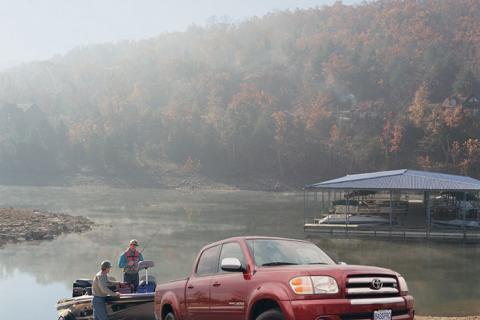
For all the relaxation fishing and boating can provide, it's amazing the level of stress often experienced at the launch ramp. Much of the tension can be avoided by simply adhering to a code of boat launch etiquette.
Use the Tie-down Area to Prep and Button-down the Boat
 |
| Launching preparations, such as removing the transom straps, should be done in an area away from the ramp. |
For those waiting in line to launch, probably nothing is more infuriating as watching a crew pull onto the ramp and then begin the task of preparing the boat for the day's outing.
Most boat launches have a tie-down area, a place where boaters can transfer gear to the boat, rig the electronics, remove transom straps and accomplish any other details needed to get the boat seaworthy. The ramp's not the place to do this; when you pull onto the ramp, the boat should be ready for launching.
The same holds true at the end of the day. Once the boat is cranked up tight on the trailer and the safety hook has been secured, pull it to the tie-down area to button things down. If there is no formal tie-down area, use an open slot in the parking area.
Learn to Back a Trailer
One of the more stressful phases of the launching process is backing the trailer down the ramp. Many folks don't have a lot of experience at this. Trying to learn under the impatient gaze of those waiting their turn to drop their boat isn't the setting to gain the proper know-how.
The inexperienced boater should practice in an empty parking lot, such as after business hours in a shopping center. Learn to use your side mirrors; while it might be frustrating at first, the ability to use your mirrors will make life much easier for you at the ramp. There are lots of YouTube videos that provide tips on backing up. Personally, I like to keep my hand on the top of the steering wheel and turn the wheel toward any "drift" the trailer makes.
One of the keys of backing a trailer is setting it up properly so that the actual backing up is pretty much a straight shot. As you practice in an empty lot, use markers like empty soda bottles as reference points to mark each side of a simulated ramp lane. You'll know you're getting the hang of it when, as the trailer and the vehicle straighten up, you can see each marker in a side mirror. Then you have a straight line backing down the ramp. Most launches are roomy enough to allow this maneuver.
As you gain experience you'll be able to accomplish tougher launching scenarios, where you have to back in at an angle.
Shut off Headlights
One of the busiest times at the launch is right at dark, as folks return from the evening's fishing. Be sure to shut your headlights off after you've gotten your trailer in position to retrieve your boat. Otherwise, your lights will blind the person trying to back their trailer down an adjacent lane. On many newer vehicles the lights come on automatically so you might have to turn off the ignition to extinguish the headlights.
Don't Hog the Courtesy Dock
Many public launches provide a courtesy dock — a nice feature to have during the launching and retrieving tasks. You don't have to run the nose of your hull up on shore to pick up your part your partner after parking the truck; if you're alone you don't have to beach your boat to get your tow vehicle. Remember: This dock is a courtesy dock; it's purpose being to expedite the boat handling process. It's not for securing your boat while you wait to meet a fishing buddy — the one who's always a half hour late. Just like the ramp, the dictum is "get in, get out," so the space is available for the next person.
Familiarize Yourself with the Facility
 |
| When loading the boat, idle it onto the trailer and then winch it the rest of the way. |
If it's your first time at a launch facility, don't go truckin' full bore into the thick of things. Rather, pull into an open parking slot, jump out and look things over. Figure out where to ready the boat; see how the area is designed to handle the traffic flow. Some big multi-lane ramps have "in" and "out" lanes. Find this out before you pull onto the ramp. Read any signs posted by the Department of Natural Resources (DNR).
Learn to Drive a Boat on the Trailer
Many modern boat trailers are designed to have the boat driven on during the loading process. Such trailers are fairly low slung and feature hull bunks and side bunks that center the boat as it runs up on the trailer. If your trailer is of this design (ones that aren't will have several keel rollers along a center beam of the trailer), learn to load the boat this way. It's much more efficient than winching it on, a process that often requires hip boots (or wet feet) and multiple ropes if it's windy.
Power loading the boat — cracking the throttle open to run the bow right up to the stop — often scours out sand/gravel from the prop wash, creating undesirable shallow areas in the boat basin. This is especially an issue with high-powered engines. Instead, ease the boat on using lower RPMs; you can then winch the boat up the last couple of feet.
Most of the unpleasantness experienced at a boat ramp is often fueled by the rush to get out there "while they're biting." Slow down, think for a minute, and the boat launch experience can be just another part of a great day on the water...for everyone.
- 11436 views

